Christopher Ian Thoma's Blog, page 48
August 19, 2015
Review – Glenmorangie, Tùsail, (No Age Stated), 46%
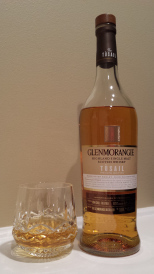 What does it mean to be an originary? I didn’t say original, I said originary. There’s a difference.
What does it mean to be an originary? I didn’t say original, I said originary. There’s a difference.
An original is the first of its kind. An originary is the cause or the source of the original. In other words, it is the compulsory producer of the original. All of the essentials rush and swirl and coagulate within its keep to become the original. What does it mean to be this?
I sometimes consider my children to be originaries. I’m sure that sounds a bit strange, but if you think about it, it really does make sense.
 Take my son Harrison, for example. Consider his bedtime ensemble pictured here. When I asked him if he was having trouble finding matching jammies, he merely responded that he put together something original and, in his words, “It looks really good.”
Take my son Harrison, for example. Consider his bedtime ensemble pictured here. When I asked him if he was having trouble finding matching jammies, he merely responded that he put together something original and, in his words, “It looks really good.”
Or consider my daughter Evelyn and the picture she drew on her placemat at Bob Evans. Looks great, yes? When I asked her what she’d drawn, she responded “What does it look like?”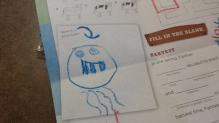
“Maybe a jellyfish, or something like that,” I said.
“It’s not a jellyfish,” she giggled. “It’s a floating head.”
“Like, floating in water,” I said a little unnerved by her response.
“No, floating above the ground. It’s a floating head.”
“Why’d you draw a floating head?”
Crossing her arms in defense, she retorted, “Why not draw a floating head?”
My point is that most folks will sit back and observe children doing these types of things and then say with genuine admiration or cutting sarcasm something like, “That li’l Billy, there, now he’s an original for sure.” In my opinion, that’s to confuse the terms. Children far surpass the designation “original.” Children are originaries. They take just about anything – legos, crayons, thoughts, sticker gems, and sometimes even pajamas – and they bring them together to produce one-of-a-kind originals. Ever since I realized this, I became a completely different kind of parent, a more interested one. I became someone who was less inclined to wait around for the kids to grow up and fulfill the substance of “original” and more interested in living in every single moment with them, plumbing the depths of all that they are as originaries. I realized that they have limitless reserves of lovely creativity and unending provisions of love, and if you go to them looking for it, they’ll always produce.
I think that in the case of the Glenmorangie Tùsail (which is the Gaelic for “originary”), the terms are confused again. Glenmorangie itself is the originary and the Tùsail is the original – and a wonderful original at that.
The nose of this delightful dram, the first of the originary’s divine constructions, is by far the stranger fellow. At first it was a bit harsh, but then I added a few drops of water. And while I typically drink my whiskies neat, the water caused the signature Maris Otter Barley to kick up in a plume of autumnal harvest enchantment.
Trailing nearby, the palate was coaxed up from the bosom of the originary and joined to the nose to reveal freshly baked barley bread lightly coated with a glaze made from spiced apples.
The finish was medium, although I’d say it bordered on short. The barley remained. When you try it, it will seem as though the harsh, or maybe sour, character in the nose returns, but just give it a moment. It will surprise you with a nip of something sweet, like a draft hard cider.
Overall, the Tùsail is a charming original, but it’s not an originary.
By the way, do you remember I mentioned sticker gems? That li’l Evelyn, there, now she’s an originary for sure.


August 17, 2015
Review – Ardbeg, Perpetuum, (No Age Stated), 47.4%
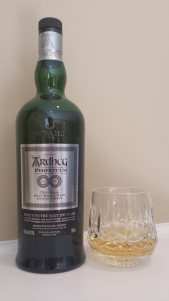 I’m not sure about the folks in Europe, but we have a game here in America that we like to play while traveling. It’s called the Alphabet Game. The game is fairly easy to play. Essentially, each player tries to be the first one to discover all twenty-six letters of the alphabet sequentially using only the passing road signs. It’s not necessarily all that much fun. It’s more of a way for passengers to pass the time, but for the driver, someone who is already bored out of his mind, it can be a diverting hoot. Having said that, and knowing the over lording nature of the American nanny state, I’m sure it’s only a matter of time before the Alphabet Game becomes illegal because it is, in fact, distracting to the driver.
I’m not sure about the folks in Europe, but we have a game here in America that we like to play while traveling. It’s called the Alphabet Game. The game is fairly easy to play. Essentially, each player tries to be the first one to discover all twenty-six letters of the alphabet sequentially using only the passing road signs. It’s not necessarily all that much fun. It’s more of a way for passengers to pass the time, but for the driver, someone who is already bored out of his mind, it can be a diverting hoot. Having said that, and knowing the over lording nature of the American nanny state, I’m sure it’s only a matter of time before the Alphabet Game becomes illegal because it is, in fact, distracting to the driver.
“License and registration, please sir… Do you know why I pulled you over?”
“Um, because I was speeding?”
“No. You were distinctly searching for a ‘Q’ in a ‘No Alphabet Game’ zone.”
“Uh. Okay.”
There are variations to the game. Some folks start in reverse order. Others allow for participants to consider license plates in the search. In my family, that’s only allowed when the game begins to lag because we are traveling through the purgatorial North Country between home and Traverse City where certain letters are nearly impossible to find, unless of course you have the eyesight of a hawk and can read the DNR tag on the ear of a bear crossing the road. In that case, it certainly counts, but you have to have photographic evidence.
 Anyway, a friend of mine posted on Facebook the image of a sign that someone at the local road commission in some desolate region of America decided to fashion for the weary travelers. Great idea. And what a kindness! In fact, I’ll bet that everyone passing that sign while in the midst of a deadlocked Alphabet Game beginning to feel a little more hell than heaven, well, I’ll bet when they behold the missive, it will feel a little like winning the lottery, or maybe what it’s like to have an angel visit your jail cell with some keys and a divine pardon.
Anyway, a friend of mine posted on Facebook the image of a sign that someone at the local road commission in some desolate region of America decided to fashion for the weary travelers. Great idea. And what a kindness! In fact, I’ll bet that everyone passing that sign while in the midst of a deadlocked Alphabet Game beginning to feel a little more hell than heaven, well, I’ll bet when they behold the missive, it will feel a little like winning the lottery, or maybe what it’s like to have an angel visit your jail cell with some keys and a divine pardon.
“Here, my child. Take these letters. You are free from the Alphabet Game. Go and sin no more.”
I was searching my cabinet for a nightcap, probing the depths for something less familiar than the usual suspects, a lesser acquaintance to engage and enliven my spirit while helping to ease me from the day’s cell into the morrow’s.
Well in the back and out of sight, I stumbled upon a bottle of the Ardbeg Perpetuum.
“Wow. Where’d you come from?”
I didn’t remember owning the Perpetuum, and discovering it as I did (or maybe rediscovering it), I felt as though I’d won a little contest. I guess I must have purchased this particular edition offered in honor of Ardbeg’s 200th anniversary alongside some other editions with the intention of eventually writing a review, but somewhere in the midst of life as usual, I’d lost it to the rear of the collection.
“Thank you, Lord. Thank you,” and I was swift to assert my authority as victor.
The nose was less charred than I expected, giving a lighter and familiar smoldering vestige which, for me, was distinctly reminiscent of the time spent burning the previous year’s Palm Sunday branches in order to make the ashes for Ash Wednesday. It’s a pleasant smell – a solemn smell.
Compared to most other Ardbeg editions, the Perpetuum’s palate was surprisingly light, giving over some campfire smoke fanning along on a coating of a gently sweetened, but still salty, marinade.
The finish was medium and edgy, leaving some singed wood and smoky sourwood honey.
I suppose that this particular edition turned out to be a little like that generous sign by the roadway, except I should say that it was a little more than just a relief from a lag in traveling amusement, it was a respite from a momentary delay in life.
Thank you, Lord. Thank you.


August 13, 2015
Review – Laphroaig, Triple Wood, (No Age Stated), 48%
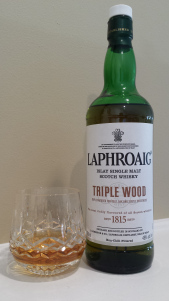 It’s a wonderful experience to go into something expecting one thing, but then getting something surprisingly better.
It’s a wonderful experience to go into something expecting one thing, but then getting something surprisingly better.
The sun was setting over my shoulder. Making my way down the hill beside our house, my solitary shadow stretched out before me on the lawn as a fitting expression of my longing for the summer day to never end.
We’d just returned from an after-dinner bike ride through town, first to the local ice cream shop and then over to the river bridge to see the dam and enjoy the rushing water. Now we were spending the last few minutes of sunlight talking and laughing and playing in the front yard.
Knowing we’d be going in soon, I was roving toward the pond with the sole intention of inspecting the shore weeds I’d treated the prior night when I heard Madeline’s affectionate voice convey to Jen, “I’m going with Daddy.”
Man, I love that sound. I truly do.
It was only a blink and a smile before I could hear her swift steps in the grass. And then in that same moment, her shadow’s hand took mine.
“Watcha doin’?”
“I’m checking the weeds I sprayed yesterday to see if they’re dying off.”
“Forget the weeds, Daddy,” she beamed and led me in another direction. “Let’s catch frogs!”
Captured for a moment by her eyes, “You’re right,” I thought to myself. “The grass withers and the flower fades without any help from me. I’m home for once, and this day will be over far too soon.”
“Yeah, let’s catch some frogs, honey,” I said.
And we were off.
It wasn’t long before the sound of our voices near the pond resonated as an enticement to the others. Harrison and Evelyn rushed to join us. Jen brought her camera. Even Josh came around the corner to see what was happening.
Man, I love this. I truly do.
Although nothing truly compares with an evening draped in such regalia, let this be a translator for my experience with the Laphroaig Triple Wood edition. I approached the whisky expecting one thing, but received something altogether better.
I’d already been cautioned that the Triple Wood might not be up to par, that is, it might be a disappointing or perhaps disjointed addition to its ancestry. Laphroaig has such a distinct nature about it, and to start fiddling with it doctrinally, well, we worshippers get a bit nervous. That anxiety certainly was upon me when I learned that the Triple Wood was finished in Oloroso sherry casks. Uh-oh. Looks like all I’ll be doing is checking on weeds and then going to bed.
But then it reached out and took me by the hand. It led me to something unexpected.
The nose of the Triple Wood is everything you would expect from Laphroaig – thick, smoky, tarry. In fact, to be quite honest, with the first inhalation came the sense that I’d merely opened another bottle of the Quarter Cask, which is one of my favorites from Laphroaig. And yet, with a little more time and a few more breaths, I noticed the sherry undertone kindled and caught in the breeze. Indeed, there was a magnificent little wisp of sweetness present, well balanced and just barely tickling the nose. Forget the weeds. Forget bedtime. There’s more fun to be had here.
With the first sip I was greeted by an exceptionally full Laphroaig whisky that seemed to have had the juice of a single raspberry squeezed into it. The juice was by no means steering the vessel, just sprinkled in and quite subtle, but very inviting. Almost immediately came the thought, “This could be the whisky that brings the clans together! This could be the one to help the highlanders meet the lowlanders.” In other words, the smoky whiskies are so often avoided by those who appreciate the cleaner, sweeter whiskies. I should know. I was that way for many years. But the palate of this particular edition could be one that helps initiate a friendliness to such folks, almost as if smiling and saying, “Come! Get your hands dirty and catch some frogs!”
The finish was medium, and in a sense, it reflected both the nosing and the palate. However, what began as a gentle sherry undertone in the nose and turned to a temperate raspberry nip in the mouth had become a more conspicuous blackberry to the tongue. All of this was swathed in the gloriously typical Laphroaig liturgy.
Man, I love this. I truly do.


August 2, 2015
My Top Fifteen for Under $75
 A request was made recently for me to provide a comprehensive list of quality scotches priced under $100. While I thought it was a reasonable request, when I went to formulate the list as it pertains to my favorites, I found that I was struggling. There are several that aren’t too bad, but so many more are hovering above the $100 mark that my better advice would be to simply save your money and get one of those. Nevertheless, I did manage to put together a top fifteen list for your enjoyment. In fact, if my memory serves me correctly, all of them fall below $75.
A request was made recently for me to provide a comprehensive list of quality scotches priced under $100. While I thought it was a reasonable request, when I went to formulate the list as it pertains to my favorites, I found that I was struggling. There are several that aren’t too bad, but so many more are hovering above the $100 mark that my better advice would be to simply save your money and get one of those. Nevertheless, I did manage to put together a top fifteen list for your enjoyment. In fact, if my memory serves me correctly, all of them fall below $75.
All of the whiskies listed below are considered “regulars” in my home. It’s just a list, though. If you want to read about the particular details involved with each edition mentioned, I’ve already done that. Each is a link to the appropriate review.
Again, they’re all worthy of your time, for sure, but I did take the time to put them in order of preference, with number one being my favorite.
Enjoy.
—————–
15. The Glenrothes – Select Reserve, (No Age Stated), 43%
14. Jura – Superstition, (No Age Stated), 43%
13. Bunnahabhain – 12 Years Old, 43%
12. Glenmorangie – Lasanta, 12 Years Old, 46%
11. Ardbeg – 10 Years Old, 46%
10. Cragganmore – 12 Years Old, 40%
9. Laphroaig – 10 Years Old, 43%
8. Ardbeg – Uigeadail, (No Age Stated), 54.2%
7. Caol Ila – 12 Years Old, 43%
6. Glengoyne – 17 Years Old, 43%
5. The Dalmore – 12 Years Old, 43%
4. Laphroaig – Quarter Cask, (No Age Stated), 48%
3. Oban – 14 Years Old, 43%
2. Auchentoshan – Three Wood, (No Age Stated), 43%
1. The Balvenie – Caribbean Cask, 14 Years Old, 43%


July 30, 2015
A Foreword by Darth Vader
 When the good Reverend called to ask if I would write the foreword for his book The Angels’ Portion: A Clergyman’s Whisky Narrative, my first thought was, “How in the hell fires of Mustafar did he find me? Everyone thinks I’m dead.” And then he mentioned jokingly that he knew all along I was still alive because he “felt it in the Force.” When I didn’t laugh, he cleared his throat and took a more serious tone.
When the good Reverend called to ask if I would write the foreword for his book The Angels’ Portion: A Clergyman’s Whisky Narrative, my first thought was, “How in the hell fires of Mustafar did he find me? Everyone thinks I’m dead.” And then he mentioned jokingly that he knew all along I was still alive because he “felt it in the Force.” When I didn’t laugh, he cleared his throat and took a more serious tone.
He began detailing the suspicion that if my son Luke, who, by the way everyone knows is much weaker than I when it comes to the Force, well, if he could survive a dosage of something like five straight minutes of the Emperor’s dark lightning, then four or five seconds of it shooting through my manly frame would probably only cause the 1980s DOS system in my helmet to flutter and reboot. The Reverend was right. That’s exactly what happened. I saw a brief “blue screen of death” and then everything was cool. But I played dead.
Maybe you folks remember that just after I chucked ol’ Palpatine into the reactor shaft (not necessarily because he was picking on Luke, but rather because of a longstanding grudge that you’ll read about in this particular volume), well, as Luke was trying to get me on the ship, I told him that it was too late for me, that I was dying. Personally, I think I deserved an Oscar for that performance. But anyway, Luke, of course, whined as he always did, “No! I’ve got to save you!” That’s when I winked and said that he already had. Here was my chance to get a brand new start.
The camera man missed it. My idiot son missed it completely. I’m guessing that all of you missed it, too.
Thinking I was gone, Luke dragged me onto the cruiser and strapped me in. While he was getting us the heck out of the unreasonably fragile and poorly designed “it’s no moon, it’s a space station” disaster that was the Deathstar, I stuffed my suit with droid parts and hid in the john. Thankfully, back on Endor, Luke didn’t even think to take me out of the suit. I don’t know if he thought he needed to get rid of me as soon as possible for the sake of getting some sort of massive life insurance check, but the little druid just tossed what he thought was his dead dad onto a pile of brush and torched me like some sort of Viking being sent off to an impatient Valhalla.
In the end, the hardest part of going off the grid was not only paying that stupid upstart hologram company to keep quiet, but to design my afterlife image so that every time Luke got whiny and called for me, I would show up next to Yoda — the two of us hovering there like indentured Genies. And it’s a good thing Luke still isn’t very sharp because he hasn’t figured out that we never speak. His dead but hologrammed father and the little green Jedi master just sit there and smile, every now and then nodding their heads in artificial affirmation. I did pay a little extra to have ol’ Obi Wan show up every now and then.
So, anyway, I’m still alive. And just so you know, I’m working as a facilities assistant at an aquatic-life park in Florida. No, it’s not SeaWorld. It’s more of a gator farm, but hey, I’m off the grid and very happy.
Still, you’re wondering how Reverend Thoma found me, right? I’m afraid I can’t share those details because if I do, others might find me, too. Let’s just say that the answer to the question is the same as if you’d asked, “Why should I buy and read a book about whisky written by a clergyman?” The Reverend is a man of detail. He pays attention, and from what I can tell, the skill seems to serve him well in finding things others cannot, most especially when he’s sipping Scotch. Add to this his careful concern for the story within each bottle. He brings out the narrative. Each one is eerily seductive, as if throughout he’s waving his hand and using the Force to either persuade you to try the whisky, or to gently urge, “This isn’t the whisky you are looking for.”
Whether you are a Rebel supporter or an Imperial lackey, you’ll appreciate this book. Personally, I take it with me every time I visit my favorite liquor store in Clearwater. I keep it in hand and refer to it before I buy anything new, and so far, the good Reverend hasn’t steered me into any asteroid fields — although, as you know, asteroid fields don’t concern me.


July 27, 2015
Detecting counterfeit whiskies – Maybe this will help…
 Not sure if that surprisingly cheap bottle of “expensive” whisky you just picked up in Thailand is counterfeit or not? No problem. I can help.
Not sure if that surprisingly cheap bottle of “expensive” whisky you just picked up in Thailand is counterfeit or not? No problem. I can help.
All you need to do is run down to the nearest electronics store for two quick purchases and then it’s off to the local liquor shop for another item.
At the electronics store, first, get some fiber optical cables and fashion them into two, well, you know, standard immersion probes – one to send the signal and the other to receive it.  The second item you’ll need to grab from the shelf is a mid-infrared spectrometer. No big deal. Now, once you have both of these items, head on over to the liquor store and purchase an authentic bottle of the edition you are testing (for a much higher price, of course), open it, and pour a little into a glass. Set the glass aside.
The second item you’ll need to grab from the shelf is a mid-infrared spectrometer. No big deal. Now, once you have both of these items, head on over to the liquor store and purchase an authentic bottle of the edition you are testing (for a much higher price, of course), open it, and pour a little into a glass. Set the glass aside.
Now, connect your cables to the spectrometer being sure that the read distance is right. Next, calibrate the device by using the little bit of whisky in the glass from the bottle you bought at the liquor store. You’ll need to do this so that the device is configured to the standard readings of an authentic edition. While you’re at it, go ahead and calibrate the spectrometer to detect methanol and sweet tea (two very common ingredients in counterfeit whisky) so at least if you discover that you’ve purchased a fake, you’ll know if you can actually drink the liquid without risking liver failure.
Once the device is ready, go ahead and tap that $1,000 bottle for which you gleefully paid $500 figuring you’d keep it in the back of the cabinet as an unopened investment edition to sell later. That’s right, shatter your dream and pour a little bit into a glass, perform the test, and compare the resulting readings with those of the authentic edition. Don’t worry. It’s the only way to be sure, and besides, you’ve already spent about $5,000 for all of the testing equipment.
And with that, no sweat, and a fine hurrah to you, my good man! You’ll know for certain if you’ve wasted $500!
How about this instead.
Don’t open the bottle. Trust that ignorance is indeed bliss and hope for the best when you go to sell it, hoping that you aren’t engaged with someone much keener than yourself when it comes to identifying forgeries. Or…
 Stop buying one-of-a-kind editions for incredibly cheap prices at little shops in Thailand. Sadly, you are the reason the whisky market is suffering from such cancerous trickery.
Stop buying one-of-a-kind editions for incredibly cheap prices at little shops in Thailand. Sadly, you are the reason the whisky market is suffering from such cancerous trickery.


July 26, 2015
Glencairn or Rock Glass… Does it really matter?
 I’m hardly enthused or interested by “artsy.” This is especially true when the artist takes such liberties with things that are meant to be practical. In my opinion, in many cases, the object of the artist’s devotion is lifted up and out of its pragmatic dominion, reimagined, retooled, and then set back down again as something useless. Take for example a fine restaurant with designer forks.
I’m hardly enthused or interested by “artsy.” This is especially true when the artist takes such liberties with things that are meant to be practical. In my opinion, in many cases, the object of the artist’s devotion is lifted up and out of its pragmatic dominion, reimagined, retooled, and then set back down again as something useless. Take for example a fine restaurant with designer forks.
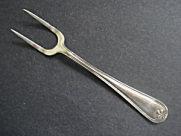 Give me a fork with a minimum of three prongs, please. If I wanted to spend the next half hour of my meal laboring to lance each diminutive morsel on my plate like a spear fisherman chasing after blacktail snapper because my fork has been redefined into a trident-like scepter with two unnaturally distant prongs, I would have asked the waiter for a proper javelin…not this stupid, little, atypical utensil that is meant only to be polished and perhaps… perhaps… admired.
Give me a fork with a minimum of three prongs, please. If I wanted to spend the next half hour of my meal laboring to lance each diminutive morsel on my plate like a spear fisherman chasing after blacktail snapper because my fork has been redefined into a trident-like scepter with two unnaturally distant prongs, I would have asked the waiter for a proper javelin…not this stupid, little, atypical utensil that is meant only to be polished and perhaps… perhaps… admired.
As you may have guessed, my aversion to artsy utensils caused me to be a bit skeptical the first time I encountered the Glencairn whisky glass. In fact, the first time I actually used one, with its strangely narrowed gate, my initial thought was that some poor soul whose nose was a little bit too close to his mouth might not even be able to gather a taste without being forced to tip his head back significantly and uncomfortably. It seemed as though it could be logistically cumbersome for some. But I gave it a try. When it comes to “artsy,” this time the dreamer made the utensil better, but by my estimations, in two ways that won’t be lost on the average whisky drinker sipping from a rock glass and unacquainted with the Glencairn means.
 To once again confirm the two aforementioned “ways” for myself before writing this particular commentary, I took the opportunity to gather a few favorites and to give them a whirl between glasses. Tiny sips, mind you. No water. Just whisky. The results were as I’d previously concluded.
To once again confirm the two aforementioned “ways” for myself before writing this particular commentary, I took the opportunity to gather a few favorites and to give them a whirl between glasses. Tiny sips, mind you. No water. Just whisky. The results were as I’d previously concluded.
First of all, the Glencairn improves the nosing experience in that the whisky’s aroma is allowed to gather in the wider bowl and is then condensed and sharpened as it is carried up through the rim by inhalation. A regular rock glass cannot do this. 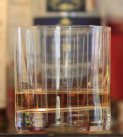 Second, since the Glencairn continues to hold closely to the nose during sipping, the aromas enliven the experience of the palate, causing for quite an exceptional transition from one to the other. Again, while the rock glass doesn’t entirely fail here, it certainly isn’t working with the measure of precision inherent to the Glencairn.
Second, since the Glencairn continues to hold closely to the nose during sipping, the aromas enliven the experience of the palate, causing for quite an exceptional transition from one to the other. Again, while the rock glass doesn’t entirely fail here, it certainly isn’t working with the measure of precision inherent to the Glencairn.
Of course, if you are drinking your whisky from a regular old rock glass, well and good. It works. In truth, I do all of my reviews using the same Waterford crystal rock glass you see in pretty much all of my photos. I rarely use a Glencairn glass. But if your senses are properly honed and you are seeking to experience a whisky rather than simply drink it, reach for the Glencairn. Aside from having your whisky intravenously infused, it’s about as close to becoming one with any given edition as you’ll ever get. It really does make a difference.






